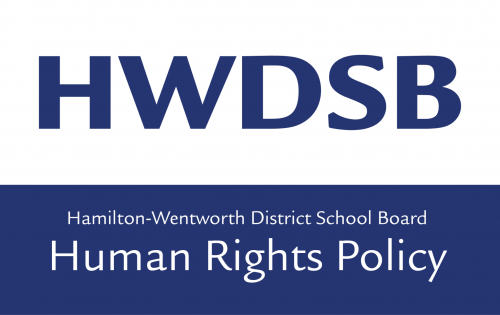

Hamilton-Wentworth District School Board (HWDSB) recognizes that protecting human rights is an important part of its mission in empowering students to learn and grow to their full potential in a diverse world.
What we did
HWDSB has developed a pillar human rights policy to help everyone understand their human rights, roles and responsibilities in HWDSB learning and working spaces. The human rights policy serves as an anchor to related policies and further HWDSB’s commitment to foster and maintain a culture of human rights, so that:
- Everyone is treated with dignity and respect
- Everyone is supported and accepted
- Everyone is free from discrimination and harassment
- HWDSB’s learning and workspaces are welcoming, respectful, accessible and free from systemic discrimination, harassment and different forms of oppression.
This policy reflects the voices of the communities we serve, especially those that often experience discrimination due to their race, gender, disability, ethnicity, religion, place of origin, ancestry, sex or gender identity, gender expression, sexual orientation, age, family status and other reasons. All HWDSB community members (students, parents, caregivers, guardians, staff, volunteers, community partners and community members) were invited to share their perspectives to inform the human rights policy and procedure during the consultation period before the policy was approved in October 2022.
You Spoke. We listened.
The Human Rights Policy went through two phases of public consultation:
- The first phase included an initial community engagement activities was used to inform the first draft of the policy including:
- online surveys
- written submissions
- committee meetings
- and virtual listening sessions
- The second phase invited students, staff, parents, guardians and community members to review the draft policy and provide further input via surveys and listening engagement sessions. This valued feedback was reviewed and taken into consideration as the final Human Rights Policy was written.
We thank all who shared their feedback, ideas and lived experiences during both phases of community engagement. Your voices are valued and played a critical role in the development of the final policy.
The final version Human Rights Policy was approved by the Board in October 2022. The full policy can be viewed here. This policy is scheduled to be reviewed next in 2026.
Information on major themes and feedback from the consultation phases can be found in this report.
Under the Ontario Human Rights Code and the Education Act, HWDSB is responsible for ensuring that learning and work environments are safe, inclusive and free from discrimination, bias, harassment and all forms of oppression. HWDSB has a variety of policies and procedures that relate to some tenants of human rights, but there is a need for a pillar human rights policy that sets clear standards and outlines how they will be applied. The HWDSB Human Rights Policy:
- promotes and protects human rights within the HWDSB community;
- sets out rights, roles and responsibilities of students, parents, staff and the HWDSB itself;
- establishes accountability to remove barriers that may result in discrimination and find resolution when human rights-related concerns occur.
Frequently Asked Questions
| Why do we need a human rights policy? | HWDSB is responsible for ensuring that learning and work environments are safe, inclusive and free from discrimination, bias, harassment and all forms of oppression. HWDSB has a variety of policies and procedures that relate to some tenants of human rights, but there is a need for a pillar human rights policy that sets clear standards and outlines how they will be applied. The HWDSB Human Rights Policy:
|
| Why did you engaging and consulting? | Students, staff and families often share that navigating the HWDSB system and finding supports isn’t easy. Some share that they don’t understand the process of reporting and resolving incidents. To build trusting relationships with impacted communities, specially students and their families, the development of the human rights policy needs to start from listening. The process of engaging with stakeholders is crucial to identifying the barriers that students, families and staff are facing and creates a policy/procedure that is responsive and address the issues.
A policy public consultation was also be conducted after the drafting of the policy to gather further input and feedback to inform the drafting of the final policy. The draft policy was be available to the public for 30 days to comment on and provide input/feedback. |
| Who was be engaged and consulted? | As much as possible, we wanted to hear from all HWDSB stakeholders, prioritizing the needs of students at all levels and with a targeted approach to hear from diverse communities that experience discrimination due to disabilities, race, gender, sexual orientation, ancestry, ethnicity, religion, economic status and other code grounds. Through this consultation we engaged and consulted with: Students, Parents/ guardians/caregivers, Staff, Unions, Trustees, Community Advisory Committees, Community partners and Critical friends. |
| How did you engaging and consulting? | Engagement and consultation was be carried out using: surveys, public meetings/ focus group discussions, outreach to specific groups, interviews, written email submissions, audio/video submissions. |
| What were the questions that were discussed in the listening sessions? | The Guiding Question included:
|
Important Reminder
If you have a specific human rights concerns or complaints that you would like to raise, contact the HWDSB Human Rights Office by:
- emailing us at [email protected] or
- Filling out this human rights complaint intake form
Resources:
- Human Rights Policy (html)
- Human Rights Accountability Procedure
- Human Rights Complaint Resolution Procedure
- HWDSB Policies Page
Policy Consultation Process and Resources
- Human Rights Policy Framework and Development Plan Presentation
- Human Rights Policy Development Engagement and Consultation Plan
- Glossary of Terms
Updated on Tuesday, April 15, 2025.

